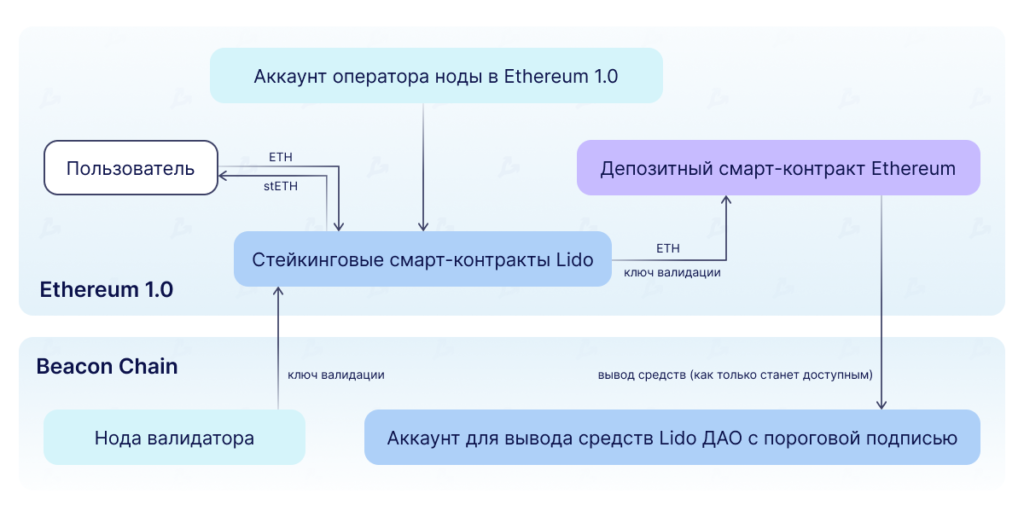
the main thing
- Lido Finance is a service for liquid staking of cryptocurrencies.
- The protocol allows you to depositcoins into a staking contract and receive in returnan equal amount of “derivative” tokens that provide liquidity to the invested assets. Thus, the user can continue to use the cryptocurrencies blocked in the staking contract for financial transactions. For example, deposit them into liquidity pools.
- The most popular asset among Lido users is ETH, in exchange for which you can get the stETH token. It, in turn, is supported by many popular decentralized exchanges.
- Lido controlled a decentralized autonomous organization (DAO), which is managed by LDO tokens. The service also supports staking of several other cryptocurrencies.
Who created Lido and when?
The project was founded by Konstantin Lomashuk and VasilyShapovalov. Initially, Lido was tested on the Goerli test network. The staking service launched on December 19, 2020. At the start of the project, LDO management tokens were issued, which are used in voting.
December 2020 The project raised $2 million.The investors were Semantic Ventures, ParaFi Capital, Terra, Stakefish, Staking Facilities, as well as MakerDAO founder Rune Christensen, Aave CEO Stani Kulechov, and Synthetix founder Kane Warwick.
Subsequently, the Paradigm fund invested 15,120 ETH in Lido, receiving 70 million LDO. The investment was approved by a vote of the DAO. In March 2022, the service raised $70 million from Andreessen Horowitz.
The first crypto asset available for liquid staking through Lido was ETH.
What problems does Lido solve?
The Ethereum network is gradually moving to an algorithmProof-of-Stake consensus. A key milestone in the process is the rollout of Beacon Chain, which began in December 2020. The network allows users to contribute funds to staking.
ETH holders can become validators, whichwill allow them to form blocks and receive rewards. However, running a node requires infrastructure and computing resources. ETH holders have the opportunity to earn passive income by delegating funds to validators.
Launch of Ethereum 2.0 goes through several stages, which requires blocking tokens for a long time. The funds are expected to be unusable until the end of 2022. During the specified period, validators have no opportunity to receive rewards.
Stakers can only enable or disable a host. If the latter is not maintained, validators may be subject to slashing and other penalties.
The reasons for the malfunction of the node can beserve as non-standard software or loss of connection. These factors increase the risks of staking, as early withdrawals are not possible.
Beacon Chain Requires Validator to Lockan amount that is a multiple of 32 ETH. This limitation is not essential for large investors. However, owners of small capital, for example, 16 ETH, cannot become validators. Holders of an amount less than 64 ETH do not have the opportunity to use a significant part of the funds for staking.
Lido solves the problems discussed. The service provides the delegation of ETH to reliable validators and allows you to deposit any amount, as well as use derivative financial instruments.
How does Lido work?
With Lido, users lock ETH in a smart contract and receive stETH tokens in return. Market participants deposit any number of coins, which allows you to bypass the 32 ETH limit.
stETH is compatible with decentralizedapplications from the DeFi sector, which provides access to additional sources of income. Coins can be invested in liquidity pools, used as collateral for a loan, and sold on the open market.
The token has high liquidity. It is the link connecting Ethereum 1.0 and 2.0.
Staking service delegates funds to largevalidators. Income is distributed among stETH holders on a daily basis. This leads to a change in the balance of users, which takes into account rewards and penalties.
Lido charges a 10% commission onreceived income. Users will return their invested ETH and rewards once transactions begin to take place on the Beacon Chain network. At the same time, stETH tokens will be liquidated.
How does Lido work?
Lido is built on the basis of two structural components: a staking pool and an oracle.
The staking pool is implemented using smart contracts on the Ethereum network. The interaction of service participants is carried out according to the following scheme:


Data: Lido Finance.
Users deposit funds by sending ETHto the corresponding address. Smart contracts enable the issuance and burning of stETH. With their help, funds are delegated to nodes operating in the Beacon Chain network. Coins are sent to active validators in installments of 32 ETH.
The DAO adds and removes validator addresses from the list. To coordinate the work of the nodes, a smart contract is used that contains data about them.
Validators are required to generate keys on the Beacon Chain and submit them to Lido. They also need to create a separate smart contract to receive the funds used for staking.
After the withdrawal of assets becomes available, theywill be sent to user addresses on the Ethereum 1.0 or 2.0 network. In the second case, Lido uses an account that is managed with a threshold signature. DAO decides on the direction of the withdrawal of funds.
Oracle keeps track of the balance of validators in the Beacon Chain. The interaction of the parties in the Ethereum 1.0 network is implemented using smart contracts according to the diagram below.


Data: Lido Finance.
The increase in funds is due torewards, and decrease when receiving fines. Oracle collects data every day, which allows users to update their balances daily. After the validators receive rewards, an additional emission of stETH is made.
Coins are distributed among all participants,with 90% of the income received by users. The rest of the proceeds are split in half between the Lido treasury and the node operators. Thanks to smart contracts, the staking service does not require trust between the parties.
How is Lido tokenomics structured?
Staking service uses tokens LDO, stETH and "derivative" tokens from other blockchain platforms such as Polkadot (stDOT) or Solana (stSOL).
stETH (Lido Staked ETH) is a standard tokenERC-20 on the Ethereum network. The current issue of coins reflects the value of the assets owned by the owners. The release of tokens occurs after the deposit of ETH and upon receipt of rewards by validators.
LDO (Lido DAO Token) is a standard tokenERC-20 designed to control Lido. The maximum offer is 1 billion. The founders of the staking service received 64% of the specified amount. The first participants of the project received an airdrop in the amount of 0.4% of the maximum issue.
At the time of writing, there are more than290 million LDOs. The tokens of the founders of the project are blocked for one year. Over the next year, the coins will be at the disposal of the owners. Accordingly, all tokens will be unlocked within two years.
Who runs Lido?
Lido is managed by a DAO, allowing flexibilitychange the parameters of the staking service. The organization ensures the regulation of commissions, the adoption of updates and improvements. The voting mechanism can also be changed. In polls, users use LDO tokens, the weight of the vote is proportional to the number of coins.
Autonomous management eliminates the failures that are typical for centralized organizations, reduces risks for users. DAO allows you to develop the project using funds from the treasury. The latter contained 35% of the maximum LDO emission.
Users of the service or other entities can make proposals for the use of tokens. The DAO may issue additional coins for fundraising or marketing purposes.
Who owns Lido assets?
To stake ETH, you need to specifythe address on the Ethereum 2.0 network that is used to withdraw funds. For the service to work correctly, you need to create a private key to access the account. Its storage and use should be controlled by the DAO.
To solve this problem, Lido uses a threshold signature. The latter is divided into 11 parts, each of which belongs to a specific subject. To gain access to funds, a consensus of six or more participants is required.
Such a decision does not require trust in one personor company, but most of the owners of the address must be trusted. The Threshold Signature is a temporary solution due to how Ethereum 2.0 works.
Among the owners of the address are many well-knownindividuals and organizations. The signatories included: Chorus One, Staking Facilities, Certus One, Argent, Banteg of yEarn Finance, Alex Svanevik of Nansen, Anton Bukov of 1inch, Mikhail Egorov of Curve, Rune Christensen of MakerDAO, Will Harborn of DeversiFi, and Mustafa al-Bassam from LazyLedger.
The generation of threshold signature keys took place inthe period from December 13 to December 16, 2020, after which the account holders ensured reliable data storage. Lido intends to abandon this decision after the technical possibility appears.
What cryptocurrencies does Lido support?
As of June 2022, apart from Ethereum, the protocol supports liquid staking of several other coins:
- Solana (S.O.L.);
- Kusama (KSM);
- Polygon (MATIC);
- Polkadot (DOT).
Until May 2022, Lido also had the optionto issue derivative tokens secured by Terra coins (LUNA), however, the project removed this asset from the list of supported ones after its rapid depreciation. Subsequently, the DAO Lido voted against integration into the protocol of the Terra 2.0 network.
How is Lido developing?
Lido remains one of the most popular ETH staking solutions, and the protocol is in the top 5 in terms of the volume of funds blocked.
The staking service began cooperation withchainlink. The developers have added price channel support for the stETH token. The tool will allow you to use the coin in DeFi protocols. According to the developers, the price channel can be applied in Aave, Compound and Enzyme.
Lido developers are involved in the development of Ethereum. In April 2022, the project allocated $6 million for the development of the ecosystem and introduced the technology of distributed Ethereum 2.0 validators.
Analysts at Goldman Sachs concluded thatthat the collapse of Terra caused the "contamination" of the stETH token and increased the systemic risks of Ethereum, since Lido accounts for about a third of the total ETH locked in the staking contract.
Goldman Sachs pointed to risks due to the increase in the interconnectedness of DeFi protocols
What else to read?
What is Decentralized Finance (DeFi)?
What is a governance token?
What is Polygon (MATIC)?
What is 1inch?





